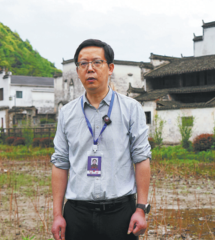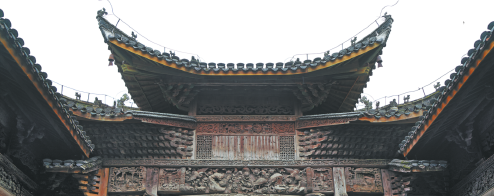Protection takes precedence
To safeguard thousands of historical structures, villages and authorities work to renovate and transform heritage, Xu Lin reports in Shangrao, Jiangxi.

Qianhe Hall, a Qing Dynasty (1644-1911) Huizhou-style mansion, features intricate wood carvings and dougong (interlocking brackets). Huizhou refers to the ancient geographic notion of parts of today's Anhui and Jiangxi provinces.
Adjacent to Qianhe Hall is Fangtang Study, built during the same era, which stands as its scholarly counterpart. Both have been carefully renovated into boutique minsu, or traditional Chinese lodgings, blending modern amenities with historical charm.
Today, Wuyuan county in Shangrao, Jiangxi province, safeguards thousands of such historical structures, some of which are renovated into minsu as examples of utilizing lower-level cultural heritage.
These two buildings were recently identified as the county's latest discoveries in China's ongoing fourth national cultural relics census, underscoring the region's role as a living archive of ancient Huizhou-style architecture.
"We plan to increase monitoring frequency, improve hidden fire safety systems, and regulate commercial operations to meet the protection standards of heritage structures," says Li Jianhua, owner of the two structures.
"Renovating heritage architecture takes priority in protecting architectural authenticity and maintaining original structures and features, while discreetly installing fire and electrical systems. Guided by the local authorities, this approach aims to prevent overdevelopment while generating tourism revenue to fund ongoing preservation," Li says.
The county allocates 8 million yuan ($1.12 million) annually to subsidize the repairs of heritage sites including ancient buildings, post roads, bridges and tombs, boosting villagers' participation in preservation efforts.
"Private capital is also welcome in protecting Wuyuan's heritage structures. Villagers can have lease agreements with tourism enterprises, retaining ownership while transferring usage rights. Companies like to invest in transforming the whole village into a minsu cluster," says Xu Yu, Party secretary of Wuyuan county's cultural heritage conservation center.
She says the humid, sweltering air and relentless termite infestations are harmful to the structures. They must be repaired regularly but the cost is high for some villagers. Some mansions have multiple owners in one family, making it difficult to coordinate with one another to renovate vacant houses.
"Funding makes renovations possible, and alterations must be approved by authorities. Such utilization can boost preservation," she says.
During the fourth national census on cultural relics in China, the county systematically documented ancient Huizhou-style mansions and identified new heritage sites, such as ancient post roads and bridges. These findings confirmed Wuyuan's role as a transportation hub of ancient Huizhou, linking the trade roads in Anhui, Jiangxi and Zhejiang provinces.
In 2024, four ancient irrigation projects in China were designated World Heritage Irrigation Structures, including the Huizhou Weirs in Anhui and the Wuyuan Weirs in Jiangxi (joint application).
"Working with the county's water resources department, we surveyed the ancient stone weirs based on their provided inventory," says Zhan Jianchun, director of Wuyuan county's cultural heritage conservation center.
These structures reflect the agricultural capabilities and irrigation engineering techniques of their time, providing valuable clues to ancient villages' settlement patterns and population distributions.
The county also surveyed the ancient wells, trees and tombs of historical figures within traditional villages. "We shifted from protecting individual relics to the comprehensive conservation of cultural heritages across the region, fulfilling the principle of leaving no cultural relics unregistered," he says.
During the Song Dynasty (960-1279), a scholar named Li Kan commissioned the construction of Zhongshu Bridge in today's Wuyuan. As part of the fourth national cultural relics census, Zhan and his colleagues rechecked the cultural heritages registered in the third national survey, including this bridge.
They consulted the Li clan genealogy, which revealed that Li was buried near the bridge. They then started to search for Li's tomb and discovered it based on villagers' clues. Based on survey findings, Li's descendants raised funds and repaired the tomb.
"The reexamination of Zhongshu Bridge yielded a significant discovery: the tomb of Li Kan. This finding tells us that a cultural relics census is not merely 'updating records' or 'registration', but involves verifying historical narratives, evaluating preservation statuses, and revealing the value of cultural heritage," Zhan says.
"Cultural relics carry rich historical information. Without proper records and protection, these invaluable memories risk fading into oblivion as time erodes their physical form and their stories."
Zhan Xiangyun, 62, uncle of director Zhan Jianchun, recalls participating in the second national census in the 1980s. As a novice, he worked with his late father Zhan Yongxuan to visit villages by bus and on foot, gathering valuable clues, painting architectural drawings by hand, and collecting artifacts from villagers for the local museum.
"No matter the task, give it your all. Whatever the role, perform it with excellence," says Zhan Xiangyun, who also joined the third national census conducted from 2007 to 2011. He is now a member of the county's team for the fourth national survey, guiding young people with his rich experience.
"I've witnessed tremendous changes over the decades. Our working conditions and equipment are much better and the locals' awareness of cultural heritage conservation has greatly improved."


































